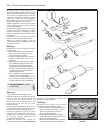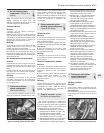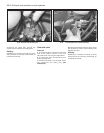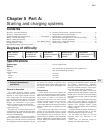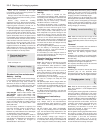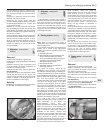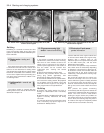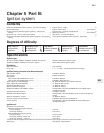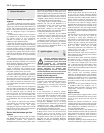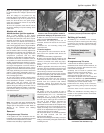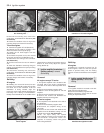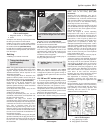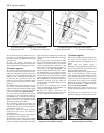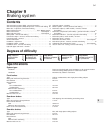
1 General information
Electronic breakerless ignition
system
A number of different breakerless ignition
systems are used on 205 models according to
engine type and fuel system fitted. Some are
simple self-contained systems and some
work in conjunction with the fuel system to
form an integrated engine management
package.
In order that the engine may run correctly it
is necessary for an electrical spark to ignite
the fuel/air mixture in the combustion
chamber at exactly the right moment in
relation to engine speed and load.
Basically the ignition system functions as
follows. Low tension voltage from the battery
is fed to the ignition coil, where it is converted
into high tension voltage. The high tension
voltage is powerful enough to jump the spark
plug gap in the cylinder many times a second
under high compression pressure, providing
that the ignition system is in good working
order.
The distributor contains a reluctor mounted
onto its shaft and a magnet and stator fixed to
its body. An ignition amplifier unit is mounted
either remotely, adjacent to the ignition coil, or
on the side of the distributor body.
When the ignition is switched on but the
engine is stationary the transistors in the
amplifier unit prevent current flowing through
the ignition system primary (LT) circuit.
As the crankshaft rotates, the reluctor
moves through the magnetic field created by
the stator. When the reluctor teeth are in
alignment with the stator projections a small
AC voltage is created. The amplifier unit uses
this voltage to switch the transistors in the
unit and complete the ignition system primary
(LT) circuit.
As the reluctor teeth move out of alignment
with the stator projections the AC voltage
changes and the transistors in the amplifier
unit are switched again to interrupt the
primary (LT) circuit. This causes a high voltage
to be induced in the coil secondary (HT)
windings which then travels down the HT lead
to the distributor and onto the relevant spark
plug.
The ignition is advanced and retarded
automatically by centrifugal weights and a
vacuum capsule or by the engine
management electronic control unit to ensure
that the spark occurs at the correct instant in
relation to engine speed and load.
Static distributorless ignition
system
A static ignition system is used on models
with MMFD Mono-point G5 and G6 engine
management systems. The system is
integrated with the fuel injection system, and is
controlled by the MMFD electronic control unit
(ECU). The ECU receives information from
various sensors, and using this information, the
optimum ignition advance for the prevailing
engine conditions is selected from a series of
“mapped” values stored in the ECU memory
(see Chapter 4B for further information).
The single ignition module replaces the
amplifier unit, HT coil and distributor in a
conventional system. The ignition module
incorporates a double coil, with four
high-tension outputs to the spark plugs,
which dispenses with the requirement for a
conventional distributor and rotor arm.
Each coil is controlled by the MMFD
electronic control unit. Each time one of the
coil primary circuits is switched, two sparks
are provided, one to a cylinder on the
compression stroke, and one to a cylinder on
the exhaust stroke. The spark to the cylinder
on the exhaust stroke is effectively a “wasted
spark”, but has no detrimental effect on the
performance of the engine.
2 Ignition system - testing
2
Warning: Voltages produced by
an electronic ignition system are
considerably higher than those
produced by conventional
ignition systems. Extreme care must be
taken when working on the system with the
ignition switched on. Persons with
surgically-implanted cardiac pacemaker
devices should keep well clear of the ignition
circuits, components and test equipment.
Models with electronic
breakerless ignition systems
Note: Refer to the warning given in Section 1
of Part A of this Chapter before starting work.
Always switch off the ignition before
disconnecting or connecting any component
and when using a multi-meter to check
resistances.
General
1 The components of electronic ignition
systems are normally very reliable; most faults
are far more likely to be due to loose or dirty
connections or to “tracking” of HT voltage
due to dirt, dampness or damaged insulation
than to the failure of any of the system’s
components. Always check all wiring
thoroughly before condemning an electrical
component and work methodically to
eliminate all other possibilities before deciding
that a particular component is faulty.
2 The old practice of checking for a spark by
holding the live end of an HT lead a short
distance away from the engine is not
recommended; not only is there a high risk of
a powerful electric shock, but the HT coil or
amplifier unit will be damaged. Similarly,
never try to “diagnose” misfires by pulling off
one HT lead at a time.
Engine will not start
3 If the engine either will not turn over at all,
or only turns very slowly, check the battery
and starter motor. Connect a voltmeter across
the battery terminals (meter positive probe to
battery positive terminal), disconnect the
ignition coil HT lead from the distributor cap
and earth it, then note the voltage reading
obtained while turning over the engine on the
starter for (no more than) ten seconds. If the
reading obtained is less than approximately
9.5 volts, first check the battery, starter motor
and charging system as described in Part A of
this Chapter.
4 If the engine turns over at normal speed but
will not start, check the HT circuit by
connecting a timing light (following the
manufacturer’s instructions) and turning the
engine over on the starter motor; if the light
flashes, voltage is reaching the spark plugs,
so these should be checked first. If the light
does not flash, check the HT leads
themselves followed by the distributor cap,
carbon brush and rotor arm using the
information given in Chapter 1.
5 If there is a spark, check the fuel system for
faults referring to the relevant part of Chapter
4 for further information.
6 If there is still no spark, check the voltage at
the ignition HT coil “+” terminal; it should be
the same as the battery voltage (ie, at least
11.7 volts). If the voltage at the coil is more
than 1 volt less than that at the battery, check
the feed back through the fusebox and
ignition switch to the battery and its earth until
the fault is found.
7 If the feed to the HT coil is sound, check the
coil’s primary and secondary winding
resistance as described later in this Chapter;
renew the coil if faulty, but be careful to check
carefully the condition of the LT connections
themselves before doing so, to ensure that
the fault is not due to dirty or poorly-fastened
connectors.
8 If the HT coil is in good condition, the fault
is probably within the amplifier unit or
distributor stator assembly. Testing of these
components should be entrusted to a
Peugeot dealer.
Engine misfires
9 An irregular misfire suggests either a loose
connection or intermittent fault on the primary
circuit, or an HT fault on the coil side of the
rotor arm.
10 With the ignition switched off, check
carefully through the system ensuring that all
connections are clean and securely fastened.
If the equipment is available, check the LT
circuit as described above.
11 Check that the HT coil, the distributor cap
and the HT leads are clean and dry. Check the
leads themselves and the spark plugs (by
substitution, if necessary), then check the
distributor cap, carbon brush and rotor arm as
described in Chapter 1.
12 Regular misfiring is almost certainly due to
a fault in the distributor cap, HT leads or spark
5B•2 Ignition system



